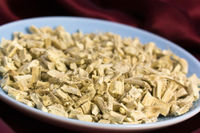Althea officinalis
| See Also | Botanical Monographs |
|---|
Perennial plant with woolly stem that grows 2-4 feet tall. Leaves are chordate, ovate with irregularly serrated margins. There is a soft downy covering of small hairs on the both sides of the leaves. Pale pink flowers consisting of five notched petals appear July - September on the upper leaf axils. Root is tapering 6-12 inches long, brown with longitudinal furrows on the outside but white and creamy on the inside. To explore the characteristics, medicinal uses and prescribing considerations of this herb in more detail, check out the references indicated.[1], [2]
Contents
Characteristics
- Common Names: Marshmallow, Cheese plant, Mortification root, Sweet weed, French: Guimauve, Spanish: Malvaisco, Greek: Iviscus, Peruvian: Altea, Turkish: Hatmi
- Family: Malvaceae
- Habitat: Althea is native to Europe and has been naturalized in the U.S. It prefers moist meadows and marshes.
- Parts Used: Roots, leaves, flowers
- Key Constituents: Root - mucilage, pectin, asparagine, tannins (1-2%); Leaves - mucilage, flavonoids, polyphenolic acids, and minerals
- Medicinal Actions: alterative, demulcent, emollient, pectoral, expectorant, vulnerary, diuretic, anti-inflammatory, nutritive, decongestant
Uses
Historical Uses:
The name Althea comes from the Greek word altha, meaning, "to cure" and suggests its long use in traditional herbal medicine. The French developed the original marshmallow confection as soft confections called "pate de guimauve," made from the root for throat infections and coughs. Today the popular candy bears the name marshmallow but does not contain any Althea, just corn syrup and gelatin.
Medicinal Uses:
Internally
- inflammation of the GI tract are relieved by althea because of its ability to soothe and coat inflamed mucosa and promote the healing of ulcerations and mouth sores.
- used for gastro-esophageal reflux, peptic ulcer, gastritis, irritable bowel syndrome, constipation, ulcerative colitis.
- Althea reduces a spasmodic and irritating cough and promotes expectoration.
- used for asthma, acute and chronic bronchitis.
- Althea is indicated in urinary infections and dysuria because the mucilage is mildly antibacterial and soothing.
Topically:
- used to treat inflammation and used for abscesses, furunculosis, leg ulcers, pharyngitis, laryngitis, varicose ulcers and burns.
Prescribing Considerations
Althea is considered to be one of the safest herbal demulcents due to the high amount of mucilage found in it. Use of the glycetract is preferred to the tincture as it better extracts the mucilage. The information provided is intended to augment the treatment from a naturopathic doctor or other trained medical professional. Although most herbs are generally safe, it is recommended that you avoid self-prescribing especially when there is an underlying ongoing medical condition, if you are on any prescription medications or if you are pregnant or breastfeeding.
Formulations and Preparation
- Infusion - overnight cold infusion, 1 tsp/cup, followed by heating briefly almost to boil, three times daily
- Tincture - 1-4mL (1:5, 25%) three times daily. In order to prevent irritation of the throat you can put the tincture in hot water to drive off some of the alcohol.
Safety
The safety and prescribing considerations for this herb include:[3] [4]
- Generally regarded as safe.
- Side Effects: low risk of side effects
- Pregnancy. No studies, use with caution.
- Contraindication: profuse catarrh or congestion of mucous membranes in respiratory conditions (empirical)
- Drug-Herb Interactions.[2]
- Oral Drugs - may delay drug absorption if taken simultaneously (speculative)
References
- ↑ Boon Heather, Smith Michael (2009) 55 Most Common Medicinal Herbs: The Complete Natural Medicine Guide Second Edition Institute of Naturopathic Education and Research, CCNM Toronto.
- ↑ 2.0 2.1 Godfrey Anthony, Saunders Paul, Barlow Kerry, Gowan Matt (2011) Principles and Practices of Naturopathic Botanical Medicine, Advanced Botanical Medicine. V3 CCNM Press, Toronto.
- ↑ Stargrove Mitchell Bebell, Treasure Jonathan, McKee Dwight L (2008) Herb, Nutrient and Drug Interactions: Clinical Implications and Therapeutic Strategies.
- ↑ Brinker Francis (1997) Herbal Contraindications and Drug Interactions: Plus Herbal Adjuncts With Medicines, 4th Edition Eclectic Medical Publications.
